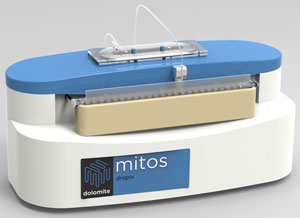Dolomite expertise brings microfluidic product to market
Posted: 21 June 2013 | | No comments yet
Fledgling spin-out company Drop-Tech has turned to microfluidics specialist Dolomite for its product development and fabrication skills…


The Mitos Dropix
Fledgling spin-out company Drop-Tech has turned to microfluidics specialist Dolomite for its product development and fabrication skills to help productize the advanced and innovative RoboDrop™ technology into the Mitos Dropix, a droplet-on-demand sampler that is set to make it easy to produce extremely miniaturized droplet compartments with excellent control over their contents. Access to this new high-throughput screening format will prove invaluable in basic research, drug discovery and diagnostics applications.


The Mitos Dropix
The collaboration began when Drop-Tech entered – and won – Dolomite’s Productizing Science® Competition, sparking discussions and exchanges of ideas between the two development teams. Liisa van Vliet, a Post-doctoral Research Associate at the University of Cambridge and Managing Director of Drop-Tech, explained: “Drop-Tech was formed from an academic collaboration between Imperial College London and the University of Cambridge. In a university environment, finding the time to convert an invention into a product is often difficult, so we welcomed Dolomite’s offer to accelerate product development, fast-tracking the transition from idea to market; Dolomite knows and understands microfluidic droplet technologies and has the engineering expertise to productize the instrument. Drop-Tech’s Technical Director Fabrice Gielen and I met with Dolomite’s product development team to discuss the internal workings of the instrument. Together, we were able to bounce ideas back and forth to incorporate improvements and determine a list of specifications.”
The Mitos Dropix sampler allows the creation of nanoliter droplet sequences from up to 24 different samples, with precise control over droplet content and size, as well as the spacing between droplets. It can be used as an add-on for conventional microfluidic chips, delivering droplets for merging, further miniaturization, dilution or any other droplet manipulation, and will also be an invaluable tool to use in conjunction with other analytical and liquid handling systems. The first batch of instruments will be with beta testers by summer 2013, and further collaboration is planned to develop droplet analysis capabilities on upcoming versions of the instrument.
Liisa concluded: “This has been a great start to our collaboration. From the beginning, our aim was to make microfluidics easier and, with Dolomite’s help, we will be able to provide scientists with an easy-to-use instrument that can dispense controlled, user-defined sequences of nanoliter droplets for a range of diverse applications.” Drop-Tech and Dolomite are already looking forward to additional Productizing Science collaborations in the future.
For more information, visit www.dolomite-microfluidics.com.




